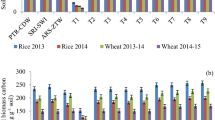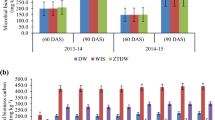Abstract
Rice–wheat cropping system in India (RWCS) is facing several problems which lead to reducing productivity and profitability. Change in the crop establishment methods (CEMs) and nutrient and water management strategies have considerable influence on both productivity and profitability. Our 2-year study at ICAR—Indian Agricultural Research Institute—showed that net return in aerobic rice system followed by (fb) zero-till wheat increased by ₹ 3416–7737 ha−1 over the conventional puddled transplanted rice fb conventional drill-sown wheat and ₹ 7864–12,376 ha−1 over system of rice intensification (SRI) fb system of wheat intensification due to savings in energy and water, even though gross return and system productivity were statistically identical in all three CEMs. Zinc fertilization increased the net return and system productivity by ₹ 5350–7670 ha−1 and 0.34–0.39 Mg ha−1 when applied with 100% recommended dose of fertilizer (120 kg nitrogen ha−1 and 25.8 kg phosphorus ha−1). Nutrient management strategy involving Anabaena–Pseudomonas biofilmed formulations improved system productivity by 350–440 kg ha−1 and net return by ₹ 9217–11,344 ha−1 over the same quantity of chemical fertilizer application. Net return was highly correlated with cost of cultivation (R2 = 0.95 and 0.99) than the gross return in both years indicating the importance of cost of cultivation in selecting CEM than gross return.



Similar content being viewed by others
References
Asada H, Matsumoto J (2009) Effects of rainfall variation on rice production in the Ganges–Brahmaputra Basin. Clim Res 38:249–260
Auffhammer M, Ramanathan V, Vincent JR (2011) Climate change, the monsoon, and rice yield in India. Clim Change. https://doi.org/10.1007/s10584-011-0208-4
Benbi DK, Brar JS (2009) A 25-year record of carbon sequestration and soil properties in intensive agriculture. Agron Sustain Dev 29:257–265
Bouyoucos CJ (1962) Hydrometer method improved for making particle size analysis of soil. Agron J 54:464–465
Chan CS, Zainudin H, Saad A, Azmi M (2012) Productive water use in aerobic rice cultivation. J Trop Agric Food Sci 49(1):117–126
Chauhan BS, Mahajan G, Sardana V, Timsina J, Jat ML (2012) Productivity and sustainability of the rice–wheat cropping system in indo-Gangetic plains of the Indian subcontinent: problems, opportunities and strategies. Adv Agron 117:315–369
Dobermann A (2004) A critical assessment of the system of rice intensification. Agric Syst 79:261–281
Dore T, Makowaski D, Malezieux E, Jolain NM, Tchamitchian M, Tittonell P (2011) Facing up paradigm of ecological intensification in agronomy: revisiting methods, concepts and knowledge. Eur J Agron 34:197–210
Erenstein O, Laxmi V (2008) Zero tillage impacts in India’s rice–wheat system: a review. Soil Tillage Res 100:1–14
Erenstein OU, Farooq RK, Malik M, Sharif (2008) On-farm impacts of zero tillage wheat in South Asia’s rice–wheat systems. Field Crops Res 105:240–252
Gomez KA, Gomez AA (1984) Statistical procedures for agricultural research. An international rice research institute book, 2nd edn. Wiley, New York
Gopalakrishnan S, Mahender Kumar R, Humayun Pagidi, Srinivas V, Ratna Kumari B, Vijayabharathi R, Singh A, Surekha K, Padmavathi Ch, Somashekar N, Raghuveer Rao P, Latha PC, Subba Rao VL, Babu RV, Viraktamath BC, Vinod Goud V, Loganandhan N, Gujja B, Rupela O (2014) Assessment of different methods of rice (Oryza sativa L) cultivation affecting growth parameters, soil chemical, biological, and microbiological properties, water saving, and grain yield in rice–rice system. Paddy Water Environ 12:79–87
Govindarasu R, Paramasivam K, Nadaradjan S, Shashidhara N, Vengatesh M (2015) Aerobic rice: a production system for water scarceness. AE Int J Sci Technol 3(6):1–4
Hanway JJ, Heidel H (1952) Soil analysis methods as used in Iowa state college Soil Testing Laboratory, vol 57. Bulletin. Iowa State College of agriculture, Iowa, p 131
Hegde DM, Sudhakara Babu SN, Aziz Qureshi A, Murthy IYLN (2007) Enhancing nutrient use efficiency in crop production—a review. Indian J Agron 52(4):261–274
Hira GS (2009) Water management in northern state and food security of India. J Crop Improv 23:136–157
Hugar AY, Chandrappa H, Jayadeva HM, Sathish A, Mallikarjun GB (2009) Influence of different establishment methods on yield and economics of rice. Agric Sci Dig 29(3):202–205
Jackson ML (1973) Soil chemical analysis. Prentice Hall of India Pvt Ltd, New Delhi
Jalota SK, Sood A, Chahal GBS, Choudhury BU (2006) Crop water productivity of cotton (Gossypium hirsutum L.)–wheat (Triticum aestium L.) system as influenced by deficit irrigation, soil texture and precipitation. Agric Water Manag 84:137–146
Kumar V, Ladha LK (2011) Direct seeding of rice: recent developments and future research needs. Adv Agron 111:297–412
Kumar V, Saharawat YS, Gathala MK, Jat AS, Singh SK, Chaudhary N, Jat ML (2013) Effect of different tillage and seeding methods on energy use efficiency and productivity of wheat in the Indo-Gangetic Plains. Field Crops Res 142:1–8
Lindsay WL, Norvell WA (1978) Development of DTPA soil test for zinc, iron, manganese and copper. Soil Sci Soc Am J 42:421–428
Mallareddy M, Padmaja B (2013) Response of rice varieties to nitrogen under aerobic and flooded condition. Indian J Agron 58(4):500–505
Naresh RK, Dhaliwal SS, Kumar D, Tomar SS, Misra AK, Singh SP, Kumar P, Kumar V, Gupta RK (2014) Tillage and rice–wheat cropping system influence on soil physical properties: water balance and wheat yield under irrigated conditions. Afr J Agric Res 9(32):2463–2474
Nayyar VK, Arora CL, Kataki PK (2001) Management of soil micronutrient deficiencies in the rice–wheat cropping system. J Crop Product 4(1):87–131
Piper CS (1950) Soil and plant analysis. The University of Adelaide, Adelaide, p 286
Prasad R (2005) Rice–wheat cropping system. Adv Agron 86:255–339
Prasad R (2011) Aerobic rice systems. Adv Agron 111:207–255
Prasad R, Nagrajan S (2004) Rice-what cropping system-food security and sustainability. Curr Sci 87(10):1334–1335
Prasanna R, Joshi M, Rana A, Shivay YS, Nain L (2012) Influence of co-inoculation of bacteria–cyanobacteria on crop yield and C–N sequestration in soil under rice crop. World J Microbiol Biotechnol 28(3):1223–1235
Prasanna R, Kumar R, Sood A, Prasanna BM, Singh PK (2006) Morphological, physiochemical and molecular characterization of Anabaena strains. Microbiol Res 161(3):187–202
Rana A, Joshi M, Prasanna R, Shivay YS, Nain L (2012) Biofortification of wheat through inoculation of plant growth promoting rhizobacteria and cyanbacteria. Eur J Soil Biol 50:118–126
Rehman H, Aziz T, Farooq M, Wakeel A, Rengel Z (2010) Zinc nutrition in rice production systems. Plant Soil 361(1–2):203–226
Rodríguez H, Fraga R (1999) Phosphate solubilizing bacteria and their role in plant growth promotion. Biotechnol Adv 17:319–339
Saito K, Linquist B, Keobualapha B, Phanthaboon K, Shiraiwa Horie T (2006) Cropping intensity and rainfall effects on upland rice yields in northern Laos. Plant Soil 284:175–185
Sankar Maruthi GR, Sharma LK, Reddy SK, Pratibha G, Shinde R, Singh SR, Nema AK, Singh RP, Rath BS, Mishra A, Behera BD, Subudhi CR, Singh B, Singh HC, Singh AK, Rusia DK, Yadava MS, Thyagaraj CR, Mishra PK, Suma Chandrika M, Venkateswarlu B (2013) Efficient tillage and nutrient management practices for sustainable yield, profitability and energy use efficiency for rice based cropping system in different soils and agro-climatic conditions. Exp Agric 49(2):161–178
Shahane AA, Singh YV, Kumar D, Prasanna R, Chakraborty D (2015) Effect of planting methods and cyanobacterial inoculants on yield, water productivity and economics of rice (Oryza sativa L.) cultivation. J Agric Rural Dev Trop Subtrop 116(2):107–121
Shivay YS, Prasad R (2012) Zinc coated urea improves productivity and quality of basmati rice (Oryza sativa L.) under zinc stress condition. J Plant Nutr 35:928–951
Shivay YS, Prasad R, Rahal A (2008) Relative efficiency of zinc oxide and zinc sulphate enriched urea for spring wheat. Nutr Cycl Agroecosyst 82:259–264
Shivay YS, Kumar D, Prasad R (2008) Effect of zinc enriched urea on productivity, zinc uptake and efficiency of an aromatic rice–wheat cropping system. Nutr Cycl Agroecosyst 81:229–243
Shukla AK, Behera SK, Shivay YS, Singh P, Singh AK (2012) Micronutrient and field crop production in India: a review. Indian J Agron 57:123–130
Singh KK, Jat AS, Sharma SK (2005) Improving productivity and profitability of rice (Oryza sativa L.)–wheat (Triticum aestivum L.) cropping system through tillage and planting method. Indian J Agric Sci 75(7):396–399
Singh YV (2013) Crop and water productivity as influenced by rice cultivation methods under organic and inorganic sources of nutrient supply. Paddy Water Environ 11:531–542
Subbiah BV, Asija GL (1956) A rapid procedure for the determination of available nitrogen in soils. Curr Sci 25:259–260
Thakur AK, Uphoff N, Antony E (2010) An assessment of physiological effects of system of rice intensification (SRI) practices compared to recommended rice cultivated practices in India. Exp Agric 46:77–98
Thakur AK, Rath S, Kumar A (2011) Performance evaluation of rice varieties under the system of rice intensification compared with the conventional transplanting system. Arch Agron Soil Sci 57(3):223–238
Timsina J, Connor DJ (2001) Productivity and management of rice–wheat cropping system: issues and challenges. Field Crops Res 69:93–132
Tripathi RS, Raju R, Thimmappa K (2013) Impact of zero tillage on economics of wheat production in Haryana. Agric Econ Res Rev 26(1):101–108
Uphoff N (1999) Agroecological implications of the System of Rice Intensification (SRI) in Madagascar. Environ Dev Sustain 1:3–4
Walkley AJ, Black IK (1934) An examination of the Degtjareff method for determination of soil organic matter and a proposed modification of the chromic acid titration method. Soil Sci 37:29–38
Author information
Authors and Affiliations
Corresponding author
Rights and permissions
About this article
Cite this article
Shahane, A.A., Shivay, Y.S., Kumar, D. et al. Crop Establishment Methods, Use of Microbial Consortia, Biofilms and Zinc Fertilization for Enhancing Productivity and Profitability of Rice–Wheat Cropping System. Agric Res 8, 44–55 (2019). https://doi.org/10.1007/s40003-018-0344-4
Received:
Accepted:
Published:
Issue Date:
DOI: https://doi.org/10.1007/s40003-018-0344-4




